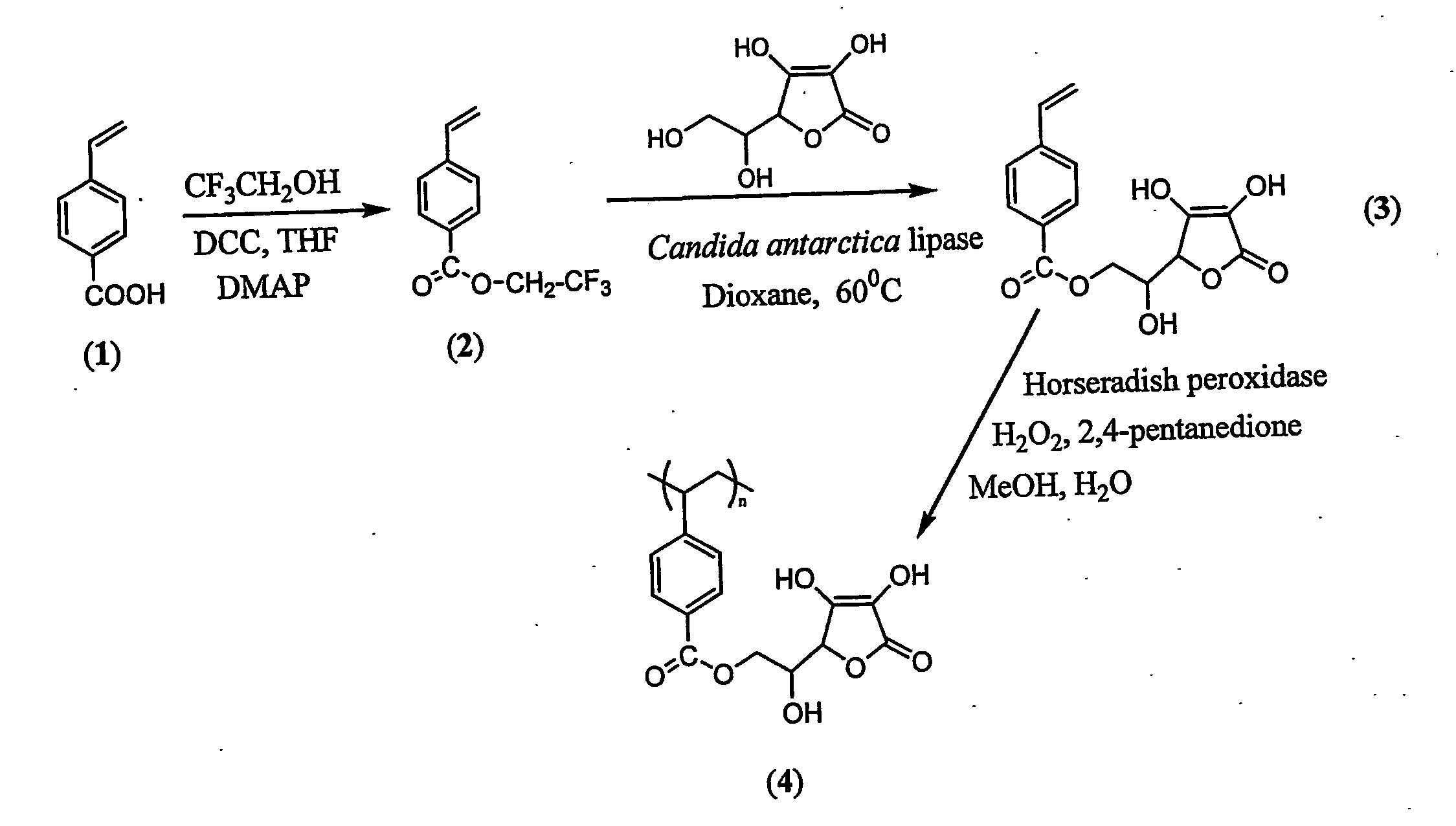Antioxidant-functionalized polymers
a functionalized polymer and antioxidant technology, applied in the field of polymer chemistry, can solve the problems of many preservatives used in food, medicine and other personal care products that have been associated with adverse side effects, unwanted and detrimental effects, and lipid degradation due to oxidation, so as to reduce the susceptibility of ascorbic acid, and improve the effect of yield
- Summary
- Abstract
- Description
- Claims
- Application Information
AI Technical Summary
Benefits of technology
Problems solved by technology
Method used
Image
Examples
example 1
Materials and Methods
(i) Materials
[0111] Horseradish peroxidase (Type II, 150-200 units / mg solid) and hydrogen peroxide (30% w / w) were purchased from Sigma Chemical Co., St. Louis, Mo. 4-Vinyl benzoic acid, trifluoroethanol, N,N-dimethylaminopyridine, dicyclohexyldicarbodiimide, tetrahydrofuran, dioxane, L-ascorbic acid, triethylamine, 2,2-diphenyl-1-picryl hydrazyl radical (DPPH●) and 2,6-di-tert-butyl-4-methylphenol were purchased from Aldrich Chemical Co., Milwaukee, Wis. Solvents used were high performance liquid chromatography grade and purchased from Fischer Scientific Co., Pittsburg, Pa. Candida antarctica lipase, immobilized, was a gift from NovoNordisk Co.
[0112]1H NMR and 13C NMR spectra were recorded using a Bruker DPX 300 spectrometer. Chemical shifts in parts per million (ppm) were referenced relative to tetramethylsilane (TMS, 0.00 ppm) as internal reference.
(ii) Synthesis of trifluoroethyl 4-vinylbenzoate
[0113] p-Vinylbenzoic acid (1) (5.0 g, 33.74 mM), trifluo...
example 2
Enzymatic Coupling of Ascorbic Acid to a Vinyl Monomer: Synthesis L-ascorbyl 4-vinylbenzoate (3) and L-ascorbyl methylmethacrylate (22)
[0114] The possible chemical pathway which results in major degradation products involves the primary hydroxyl group of ascorbic acid. The primary hydroxyl group was regioselectively protected via mild enzyme catalysed transesterification reaction which stops degradation and an active ascorbic acid was attached to the vinyl monomer (FIG. 1). This synthesis can be done was done as follows:
(i) Synthesis L-ascorbyl 4-vinylbenzoate (3)
[0115] Immobilized Candida antarctica lipase and L-ascobic acid were dried under high vacuum in a desicator with phosphorous pentoxide for 24 hours prior to reaction. The reaction approach was an enzymatic transesterification where the primary hydroxyl group of ascorbic acid is regioselectively acylated by trifluoroethyl 4-vinylbenzoate (2) via the acyl enzyme complex. In a typical reaction, L-ascorbic acid (2.0 g, 11.3...
example 3
Enzymatic Polymerization of L-ascorbyl 4-vinylbenzoate (3) and L-ascorbyl methylmethacrylate (22)
(i) Polymerized L-ascorbyl 4-vinylbenzoate (4)
[0117] The vinyl monomer functionalized with ascorbic acid was polymerized with horseradish peroxidase using initiator 2,4-pentanedione and oxidant hydrogen peroxide in 50:50 water and methanol. 2,4-Pentanedione was distilled under vacuum before use. In a general procedure, 1.8 mL water, 2.0 mL methanol were flushed with nitrogen for 10 min. L-ascorbyl 4-vinylbenzoate (3) (457 mg, 1.5 mM) was added to the reaction mixture. Horseradish peroxidase (3.56×10−4 mM, 2400 units, 16 mg) was dissolved in 200 μL of water. Hydrogen peroxide, 0.15 mM (17 μL), and 0.30 mM of 2,4-pentanedione were added simultaneously after the addition of the enzyme. Polymerization was conducted for 24 h with continuous stirring. The reaction mixture was poured into 200 mL methanol. No solid product was obtained. The polymer was soluble in excess of methanol. The exces...
PUM
| Property | Measurement | Unit |
|---|---|---|
| molecular weight | aaaaa | aaaaa |
| inherent antioxidant capabilities | aaaaa | aaaaa |
| antioxidant | aaaaa | aaaaa |
Abstract
Description
Claims
Application Information
 Login to View More
Login to View More - R&D
- Intellectual Property
- Life Sciences
- Materials
- Tech Scout
- Unparalleled Data Quality
- Higher Quality Content
- 60% Fewer Hallucinations
Browse by: Latest US Patents, China's latest patents, Technical Efficacy Thesaurus, Application Domain, Technology Topic, Popular Technical Reports.
© 2025 PatSnap. All rights reserved.Legal|Privacy policy|Modern Slavery Act Transparency Statement|Sitemap|About US| Contact US: help@patsnap.com



